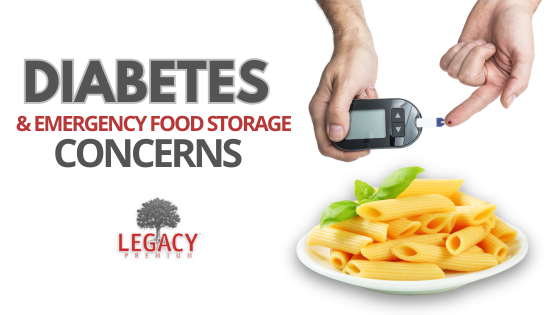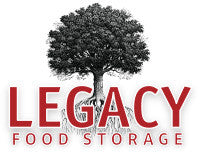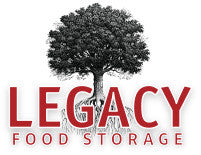
Diabetic Challenges with Food Storage
Anyone looking for food storage will recognize the familiar meals containing pasta, potatoes and rice, which are commonly found in the industry. The offerings from different companies vary in the quality, serving size, and actual recipes that comprise their foods. Long term food storage options use these ingredients because carbohydrates provide quick energy, solid calories, and they perform well in long term storage.
If you are on a general diet, typically you welcome the familiar dishes most people enjoy, such as delicious creamy pastas and chunky potato or rice medleys. However, if you are diabetic, at first glance these meals might not seem ideal, as you envision your glucose soaring with the high carbohydrate ratio.
With so many food storage companies using these high carbohydrate ingredients, customers with diabetes are left questioning what options are available for having some emergency food stored without putting their health at risk during emergencies. For diabetics, eating correctly is even more important when medical assistance might not be available and medications or insulin might need to be carefully rationed.
Basic principles of healthy eating for diabetics include portion control and counting carbohydrates to help limit blood glucose spikes. Many use the glycemic index (GI), which is an index of how certain carbohydrates may affect blood glucose levels. Carbohydrates with a low GI value (55 or less) are more slowly digested, absorbed, and metabolized and cause a lower and slower rise in blood glucose. However, research shows that both the amount and the type of carbohydrate in food affect blood glucose levels. Therefore, portion sizes are still relevant for managing blood glucose and no one single measurement works. Using the GI as an additional tool for guidance in combination with considering portion size in meal selections is recommended.
Overall, there is no one diet or plan that works for everyone with diabetes, as individual results and patterns can vary. The general rule of thumb is to favor lower carb items and limit the carbs which can cause spikes in blood glucose.
A person with diabetes can still eat our tasty meals by dosing correctly with insulin (if prescribed), or can simply reduce the serving size and add other low carb options like meats and vegetables. These increase the calories and bulk while lowering the overall carbohydrates.
Legacy includes items such as these in their Essentials line to provide healthy options or additions to their Premium food storage line for any eating plan. This provides a real benefit to those with special dietary needs to be able to enjoy good food in an emergency, including those with diabetes, gluten intolerance, low sodium, and certain food allergies.
This specialty line consists of high quality, low carb/sodium ingredients like powdered eggs, vegetables, meats, fruits, and other specialty items to be used in conjunction with our meals, or by putting together various ingredients for a complete meal creation.
Meal plans created by the American Diabetes Association (ADA) recommend 45% of calories from carbs. This includes 45–60 grams per meal and 10–25 grams per snack, totaling about 135–230 grams of carbs per day.
Here is a sample meal plan showing how someone with diabetes can use Legacy food by making some portion adjustments:

Assuming you are targeting 2000 calories per day, the meal plan above can easily reach that by adding a couple of snacks or increasing a few of the meal components.
Many food storage companies offering 2000 calorie packages will add extra calories in the form of cheap fillers, such as sugary desserts and drinks. As a diabetic or one with other dietary needs, it is better to have the option to choose these additional items on your own, than to select a package that includes these types of foods.
Rather than sugary calories, Legacy chooses to give you larger meal servings and let you pick the extra items to add calories for how you want to eat. This allows for better control in what you decide to store in your long term plan.
Below are some items included in our Essential line, many of which are fantastic lower carb options for adding additional flavor, taste, and calories. Even someone with diabetes or other needs can enjoy these foods. For additional calorie ideas, a diabetic might also choose to store nuts, dried cheese, or even some fats, like oil or butter, which can be added to meals or milk to increase the fat and calories without adding extra carbohydrates.

While someone with special dietary concerns, such as diabetes, needs to be more careful of what foods they consume, even long term food storage can be a good option by simply making some adjustments to portions and adding some additional low carbohydrate items.
If you would like a personal consultation in putting together a package, our non-commission representatives are available Monday through Friday, 8:30 am - 5:00 pm.
Tags
- All
- 25 year food
- 25 year shelf life food
- 72 hour kit
- Best food storage types
- Best long-term food storage
- Blizzard preparedness
- Budgeting
- canning
- Certified GMO-free Emergency foods
- Certified GMO-free foods
- Coffee
- Comparison of emergency food methods
- Composting tips
- Dangers of genetically modified foods
- dehydrated food
- Edible Wild Plants
- emergcy preparedness
- Emergency Cooking
- Emergency Food
- Emergency food Christmas gifts
- emergency food storage
- Emergency Food Supply
- Emergency food supply recommendations
- Emergency Planning
- Emergency Preparedness
- Emergency preparedness advice
- emergency preparednesss
- Emergency Supplies
- Emergency supplies checklist
- Emergency Survival
- emergency survival gear
- Emergency survival kit checklist
- Emergency Survival skills
- exercise
- Family emergency preparedness
- Family emergency preparedness plan
- Family Preparedness
- Food Storage
- Food storage 25 year shelf life
- Food storage amounts
- Food storage Christmas
- Food storage containers long term
- Food Storage Secrets
- Food storage serving size
- Food storage types compared
- freeze dried food
- Freeze dried food storage
- freeze dried meats
- Freeze-dried emergency food storage
- Fruit Trees
- Gardening
- Getting Started
- Gluten-free food Storage
- Gourmet emergency food
- Healthy food storage
- How much emergency food to store
- Improved emergency preparedness
- Jared Markin
- Jared Matkin
- Legacy Premium
- Lessons learned from Hurricane Sandy
- Lessons learned from natural disasters
- long-term food storage
- Long-term Food Storage Guidelines
- Long-term Food Storage tips
- Long-term water storage
- Mental Emergency Preparedness
- Mental toughness
- Money-saving tips
- Natural disaster planning
- Natural Disasters
- Perfect Christmas gifts
- Pet Emergency preparedness checklist
- Pet Emergency preparedness kit
- Pet Emergency Survival tips
- Pets and Emergency Preparedness
- Plant Foraging
- portable solar panels
- portable solar power
- portable water filters
- protein drinks
- Risk of genetic modification
- Seed saving and storage
- Seed saving guide
- Self-reliance
- Self-reliant practices
- Shelf Life
- Solar Cooking
- Solar Ovens
- Special Dietary needs
- Stranded in a car in a blizzard
- Survival food
- Survival Gear
- survival kit
- Survival kits
- Survival Ovens
- Survival Skills
- survivalist gear
- suvival kit
- Tree Pruning tips
- Tree Trimming basics
- unique ideas
- water bottle with filter
- water filter
- water filter straw
- water filters
- Water Filtration
- water pitcher with filter
- water pitchers with filters
- Water purification
- Wild Food Foraging
- Winter composting
- Winter driving
- Winter preparedness tips
- Winter storm preparedness tips
- Winter Survival







